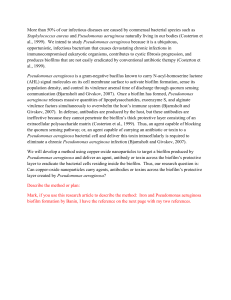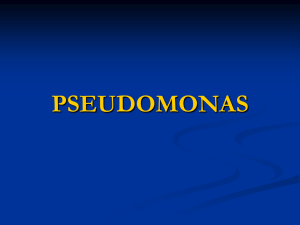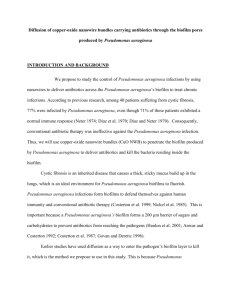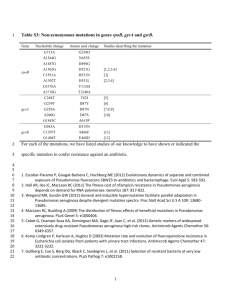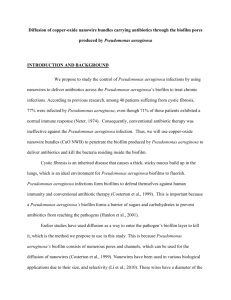Nanobots_revised_proposal
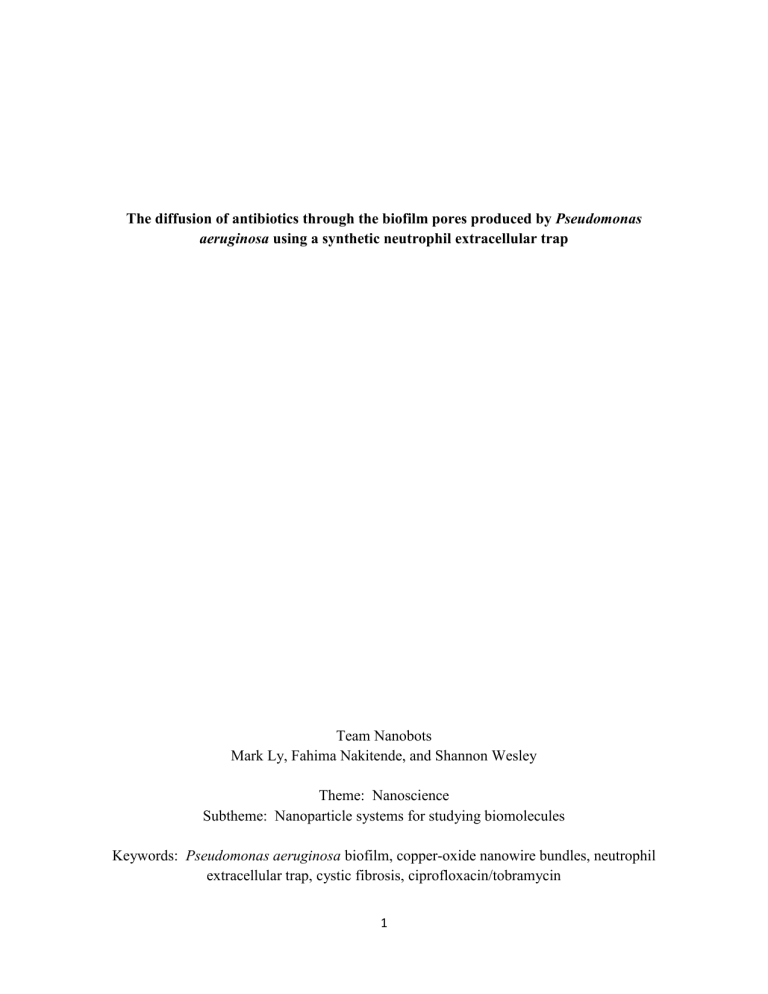
The diffusion of antibiotics through the biofilm pores produced by Pseudomonas
aeruginosa using a synthetic neutrophil extracellular trap
Team Nanobots
Mark Ly, Fahima Nakitende, and Shannon Wesley
Theme: Nanoscience
Subtheme: Nanoparticle systems for studying biomolecules
Keywords: Pseudomonas aeruginosa biofilm, copper-oxide nanowire bundles, neutrophil extracellular trap, cystic fibrosis, ciprofloxacin/tobramycin
1
PROPOSAL SUMMARY
INTRODUCTION AND BACKGROUND
We propose to study the control of Pseudomonas aeruginosa infections by using nanowires to deliver antibiotics across the Pseudomonas aeruginosa
’s biofilm to treat chronic infections. According to previous research, among 40 patients suffering from cystic fibrosis,
77% were infected by Pseudomonas aeruginosa , even though 71% of these patients exhibited a normal immune response (Neter 1974; Diaz et al. 1970; Diaz and Neter 1970). Consequently, conventional antibiotic therapy was ineffective against the Pseudomonas aeruginosa infection.
Thus, we will use copper-oxide nanowire bundles (CuO NWB) to penetrate the biofilm produced by Pseudomonas aeruginosa to deliver antibiotics and kill the bacteria residing inside the biofilm.
Cystic fibrosis is an inherited disease that causes a thick, sticky mucus build up in the lungs, which is an ideal environment for Pseudomonas aeruginosa biofilms to fluorish.
Pseudomonas aeruginosa infections form biofilms to defend themselves against human immunity and conventional antibiotic therapy (Costerton et al. 1999; Nickel et al. 1985). This is important because a
Pseudomonas aeruginosa’s biofilm forms a 200 µm barrier of sugars and carbohydrates to prevent antibiotics from reaching the pathogens (Hanlon et al. 2001; Anwar and
Costerton 1992; Costerton et al. 1987; Govan and Deretic 1996).
Earlier studies have used diffusion as a way to enter the pathogen’s biofilm layer to kill it, which is the method we propose to use in this study. This is because Pseudomonas aeruginosa’s biofilm consists of numerous pores and channels, which can be used for the diffusion of nanowires (Costerton et al. 1999; Stewart 1996).
2
Nanowires have been used in various biological applications due to their size and selectivity (Li et al. 2010; Bao et al. 2008; Lu et al. 2007). These wires have a diameter of the nanometer scale, which can have different shapes and properties depending on the material they are made of. And, we can arrange these nanowires into nanowire bundles to form a synthetic mesh-like net that will increase the available surface area for antibiotic attachment.
Metal ions have been used by Harrison (2005) to kill the pathogen by diffusing metal ions through the Pseudomonas aeruginos’s biofilm. In addition, the results showed that a high concentration and long exposure time of various metal ions were able to completely eliminate the biofilm. And, the lengthy exposure time was a result of cationic binding of the metal ions to the biofilm that restricted the rate of penetration. Harrison (2005) also determined that 40 mM of lead, 120 mM of zinc, 140 mM of cobalt and nickel, and 300 mM of aluminum metal ions were required to destroy a biofilm, whereas only 30 mM of copper was required to have the same outcome. Thus, we decided to make our nanowires out of copper because copper was effective at low concentrations and non toxic to biological systems.
Therefore, we will use electrostatics to compose CuO NWB antibiotic carriers. We predict the antibiotics will occupy the positive charge on the CuO NWBs and will not adhere to the surface of the biofilm during diffusion.
Previous research performed by Walters et al. (2002) demonstrated tobramycin and ciprofloxacin eventually penetrated the biofilm, but failed to kill Pseudomonas aeruginosa once inside the biofilm. As indicated by Figure 1, both ciprofloxacin and tobramycin did not increase
Pseudomonas aeruginosa
’s mortality rate over a 100 hour exposure time.
3
Figure 1. Killing of P. aeruginosa in biofilms in exposure to ciprofloxacin (A) and killing of P. aeruginosa in biofilms in exposure to tobramycin (B). Filled squares were the treatment and the unfilled were the controls (Walter et al. 2002)
Thus, the ineffectiveness of these antibiotics was not because of poor penetration, but oxygen limitation and low metabolic activity inside the biofilm. A lack of oxygen within the biofilm either prevented Pseudomonas aeruginosa growth or the action of the antibiotics; whereas, free swimming bacterial cells were susceptible to tobramycin and ciprofloxacin. For these reasons, we decided to use these two antibiotics in conjunction with our CuO NWBs to kill the pathogen inside the biofilm. These bundles will not block the Pseudomonas aeruginosa biofilm pores because of their nanometer size. Therefore, oxygen transport will be restored, metabolic activity will continue as normal, and we will be able to spread the antibiotics over a larger area. So, by combining these antibiotics to our CuO NWBs we are creating a synthetic neutrophil extracellular trap (synNET).
4
According to Brinkmann (2004), white blood cells in a normal immune response form a neutrophil extracellular trap (NET)
Figure 2. Neutrophil extracellular trap (NET). by secreting proteins and chromatin. This NET traps the pathogen and prevents damage to the adjacent tissues at the site of infection.
NETs bind to bacterial cells, prevent the spread of infection, and kill the pathogen using antimicrobial agents (toxins, chemicals, or antibodies) (Weinrauch et al. 2002). As a result of these above advantageous properties, we will use a bundle of nanowires to imitate a NET and trap the pathogen.
According to Tirouvanziam (2007), NETs are rapidly killed by toxins released by the bacterial cells making them ineffective. This is why patients with cystic fibrosis are continuously suffering from recurring episodes of Pseudomonas aeruginosa infection. So, could
CuO NWBs carrying antibiotics diffuse through the porous structure of Pseudomonas aeruginosa’s biofilm and act as a synNET?
We hypothesize that CuO NWBs will imitate a NET and carry antibiotics through the biofilm of Pseudomonas aeruginosa to kill the pathogen from the inside . If this synNET carrying antibiotics diffuses through the biofilm successfully and if the antibiotics detach from the synNET inside the biofilm, we predict no growth on the antibiotic/CuO NWB agar plates.
5
PROPOSED RESEARCH
The aim of our study is to determine the effectiveness of ciprofloxacin and tobramycin coupled CuO NWBs against Pseudomonas aeruginosa biofilm growth.
We will grow Pseudomonas aeruginosa biofilms every three days to avoid biofilm degradation which usually occurs at about 48 hours and to ensure a constant 24 hour aged biofilm for testing (D. Storey, pers. Commun.). Also, we will synthesize one set of CuO NWBs for each antibiotic.
Pseudomonas aeruginosa Biofilm Synthesis
We will follow Harrison’s (2006) procedure shown in Figure 1 to grow
Pseudomonas aeruginosa biofilms using the Calgary Biofilm Device (CBD) with the exception of using the scanning electron microscopy method.
Figure 1. The experimental design to synthesize Pseudomonas aeruginosa biofilms, using Luria-
Burtani Broth (LB) and the Calgary Biofilm Device (CBD) system; and examination of the biofilm’s structure using confocal laser scanning microscopy (CLSM) equipment (Harrison,
2006).
6
A confocal laser scanning microscope (CLSM) and its 3D imaging properties will be used to examine the biofilm’s structure and confirm the presence of pores. Only biofilm structures containing pores will be used in this research study to make sure diffusion transport is accessible.
Ciprofloxacin and Tobramycin
We will purchase 100 mg of deprotonated (negatively charged) ciprofloxacin and tobramycin from Sigma-Aldrich.
Walter’s et al. (2002) procedure will be used to test ciprofloxacin and tobramycin against
Pseudomonas aeruginosa biofilms as our control. This will ensure that these two antibiotics are ineffective against Pseudomonas aeruginosa biofilms individually.
Synthesis of CuO NWBs
We will follow the methods outlined by Li et al. (2010) to synthesize the CuO NWBs.
We will create a one dimensional nanowire and combine it with an aqueous solution of CuCl
2
.
This composite solution will be vacuum filtered and dried in an oven to produce our nanowires composition. The initial template will be removed with a solution of NaOH and the copper-oxide nanowire bundles will dry a final time. Creating our CuO NWBs will take 24 hours to complete.
We will determine the structure and correct chemical composition of our CuO NWBs by using transmission electron microscopy (TEM) and X-ray diffraction (XRD). This will guarantee our
CuO NWBs are self assembled correctly.
Synthesis of synNETs
To attach our antibiotics, we will use electrostatic interactions (CuO NWBs positive charge with the antibiotics negative charge) to couple with our CuO NWBs. A solution of
7
ciprofloxacin/tobramycin will be cast onto the CuO NWBs separately and then slowly evaporated to produce our synNETs. These synNETs will be stored in a refrigerator (4 ℃ ).
We will follow Li’s et al. (2010) characterization method to characterize our synNET.
Fourier transform-IR (FT-IR) spectra will be performed using a Nicolet Avatar mass spectrometer from the University of Calgary’s Chemical Instrumentation Facility to compare three different peaks: the CuO NWBs individually, the antibiotic individually, and the antibiotic coupled with our CuO NWBs. If our antibiotics coupled with our CuO NWBs successfully, we expect to see a spectra that combines both individual peaks: CuO NWBs and antibiotic.
One factor that could affect our results is the strength of the electrostatic interaction between the antibiotics and the CuO NWBs. If the interaction is too weak then the CuO NWB may attach to the biofilm layer instead of the antibiotic, and the CuO NWB will not deliver the antibiotic across the biofilm layer.
Controls and Test Samples
Pseudomonas aeruginosa biofilms in 96 welled MBEC plates will be randomly exposed to each parameter listed in Table 1 below:
Table 1. Experimental group parameters tested with Pseudomonas aeruginosa biofilms.
A
B
C
D
TREATMENT
Control
Antibiotic only
Nanowire only
Nanowire + Antibiotic
EXPERIMENTAL TREATMENT
PARAMETERS
No antibiotic
No copper-oxide nanowire
Antibiotic
No copper-oxide nanowire
No antibiotic
Copper-oxide nanowire
Antibiotic fused
Copper-oxide nanowire
EXPECTED
RESULT
Growth
Growth
Limited growth
(copper-oxide toxicity)
No growth
(antibiotic penetration)
8
To prepare each of our test group parameters in Table 1 above, we will follow the procedures outlined in Table 2 below:
Table 2. Experimental treatment group preparations.
A
B
C
D
TREATMENT
Control
Antibiotic only
PREPARATION PROCEDURE
Add 200 µL of 0.9% NaCl to 24 wells of a 96-well
MBEC plate of a randomly selected region (A,B,C, and D) (Fig. 2)
Add 200 µL of antibiotic to 24 wells of a 96-well
MBEC plate of a randomly selected region (A,B,C, and D) (Fig. 2)
Nanowire only Add CuO NWBs to 24 wells of a 96-well MBEC plate containing 200 µL of 0.9% NaCl of a randomly selected region (A,B,C, and D) (Fig. 2)
Nanowire + Antibiotic Add 200 µL of diluted antibiotic fused copper-oxide nanowires to 24 wells of a 96-well microtiter plate of randomly selected regions (A,B,C, and D) (Fig. 2)
Figure 2. A MBEC plate illustrating the regions of the treatment parameters: control, antibiotic only, nanowire only, and antibiotic coupled CuO NWBs. Each treatment will consist of 24 out of the 96 wells and will be rotated between regions A, B, C, and D (Ceri et al. 1999).
9
Experimental Procedure
The first day we will g row Pseudomonas aeruginosa biofilms and synthesize CuO NWBs.
Then, we will routinely repeat the following 3 day outline for the duration of our 8 month experimentation with 2 days of intermittent data collection.
Day 1
Day 2
Day 3
-
-
-
-
Confirm Pseudomonas aeruginosa collect A treatment results biofilm growth using CLSM and
Confirm the presence of copper on the CuO NWBs using TEM & XRD
Synthesize ciprofloxacin and tobramycin coupled CuO NWBs
Confirm proper coupling using FT-IR
Start B treatment and incubate 24 hours (35 ℃ )
Sonicate biofilm pegs, start C treatment, and incubate 24 hours (35
Sonicate biofilm pegs, start D treatment, and incubate 24 hours (35
Collect B treatment results
Collect C treatment results
Collect D treatment results
Grow Pseudomonas aeruginosa biofilms
Sample Size
We expect limited growth once we penetrate the biofilm layer of Pseudomonas
℃
℃
)
) aeruginosa with our synNET. To determine the sample size (N) we will use a chi-squared logistical model to determine the noncentrality parameter (λ) using the formula N = λ / w
2
. The effect size (w) is the effect we are interested in detecting. With our growth and no growth model we expect to see a medium effect size of 0.3. With 14 degrees of freedom in our experimental design, we obtained a noncentrality parameter of 27.2. The sample size that is required for our experiment is 303. Thus, we will need at least 13 MBEC plates to get the required sample size.
10
Analysis and Interpretation
Harrison’s (2006) viable cell counting procedure will be used to determine the mean amount of Pseudomonas aeruginosa biofilm growth after being exposed to three different treatments (Fig. X ).
Figure 3. Diagram of experimental procedure used for group tests B, C, and D (Table 1). Step D above will incubate with antibiotics for group tests B and D and with copper oxide nanowires for group tests C and D (Herrmann, 2010). Cross out G
From our collected data, a one-way fixed effect ANOVA statistical test will be performed to compare the mean colony forming units (CFUs) for our three different treatments. The
ANOVA statistical test will determine any growth differences between our antibiotic only, CuO
NWBs only, and synNETs.
Our expected results from the ANOVA statistical test should reveal 100% growth in the control and antibiotic only treatments, less than 100% growth in the CuO NWBs only treatment, and 0% growth in the antibiotic coupled CuO NWBs treatment. If our experimental results correlate with our expected results presented above, then our synNETs can be used as an alternative therapy for Pseudomonas aeruginosa biofilm infections. In addition, future studies
11
could be conducted to determine the optimum concentration of CuO NWBs (without using antibiotic coupling) needed to effectively kill Pseudomonas aeruginosa biofilm growth.
12
LITERATURE CITED
Anwar H, Costerton JW . 1992. Effective use of antibiotics in the treatment of biofilm-associated infections. American Society for Microbiology News. 58 : 665–668.
Bao SJ, Li CM, Zang JF, Cui XQ, Qiao Y, Guo J. 2008. New nanostructured TiO2 for direct electrochemistry and glucose sensor applications. Advanced Functional Materials. 18: 591-599.
Brinkmann V, Reichard U, Goosmann C, Fauler B, UhlemannY, Weiss SD, Weinrauch Y,
Zychlinsky A. 2004. Neutrophil extracellular traps kill bacteria. American Association for the
Advancement of Science. 303: 1532-1535.
Ceri H, Olson ME, Stremick C, Read RR, Morck D, Buret A. 1999. The Calgary biofilm device:
New technology for rapid determination of antibiotic susceptibilities of bacterial biofilms.
Journal of Clinical Microbiology. 37:1771-1776.
Costerton JW, Cheng KJ, Geesey GG, Ladd TI, Nickel JC, Dasgupta M, Marrie TJ. 1987.
Bacterial biofilms in nature and disease. Annual Reviews of Microbiology. 41: 435–464.
Costerton JW, Stewart PS, Greenberg EP. 1999. Bacterial biofilms: A common cause of persistent infections. Science. 284: 1318-22.
Diaz F, Mosovich LL, Neter E. 1970. Serogroups of Pseudomonas aeruginosa and the immune response of patients with cystic fibrosis. Journal of Infectious Diseases. 121: 269-274.
Diaz F, Neter E. 1970. Pseudomonas aeruginosa: Serogroups and antibody response in patients with neoplastic diseases. American Journal of the Medical Sciences. 259: 340-345.
Govan JRW, Deretic V. 1996. Microbial pathogenesis in cystic fibrosis: mucoid Pseudomonas aeruginosa and Burkholderia cepacia. Microbiological Reviews. 60: 539–574.
Hanlon WG, Denyer Ps, Olliff JC, Ibrahim JL. 2001. Reduction in exopolysaccharide viscosity as an aid to bacteriophage penetration through Pseudomonas aeruginosa biofilms. American
Society for Microbiology. 67: 2746-53.
Harrison JJ, Turner RJ, Ceri H. 2005. Persister cells, the biofilm matrix and tolerance to metal cations in biofilm and planktonic Pseudomonas aeruginosa. Biofilm Research Group. University of Calgary. 7: 981-94.
13
Harrison JJ, Ceri H, Yerly J, Stremick CA, Hu Y, Martinuzzi R, Turner RJ. 2006. The use of microscopy and three-dimensional visualization to evaluate the structure of microbial biofilms cultivated in the Calgary biofilm device. Biological Procedures Online. 8:194-215.
Herrmann G, Yang L, Wu H, Song Z, Wang H, Hoiby N, Ulrich M, Molin S, Riethmuller J,
Doring G. 2010. Colistin-tobramycin combinations are superior to monotherapy concerning the killing of biofilm Pseudomonas aeruginosa. The Journal of Infectious Diseases. 202:1585-1592.
Li Y, Zhang Q, Li J. 2010. Direct electrochemistry of hemoglobin immobilized in CuO nanowire bundles. Talanta. 83: 162-66.
Lu X, Zou G, Li J. 2007. Hemoglobin entrapped within a layered spongy Co3O4 based nanocomposite featuring direct electron transfer and peroxidase activity. Journal of Materials
Chemistry. 17: 1427-1432.
Neter E. 1974. Pseudomonas aeruginosa infection and humoral antibody response of patients with cystic fibrosis. The Journal of infectious diseases. 130: 132-133.
Nickel JC, Ruseska I, Wright JB, Costerton JW. 1985. Tobramycin resistance of Pseudomonas aeruginosa cells growing as a biofilm on urinary catheter material. Journal of Antimicrobial
Agents and Chemotherapy. 27: 619-624.
Stewart PS. 1996. Theoretical aspects of antibiotic diffusion into microbial biofilms. Journal of
Antimicrobial Agents and Chemotherapy. 40: 2517-2522.
Tirouvanziam.R, Gernez Y, Conrad KC, Moss BR, Schrijver I, Dunn EC, Davies AZ,
Herzenberg AL, Herzenberg AL. 2007. Profound functional and signaling changes in viable inflammatory neutrophills. National Academy of Science. 105: 4335-4339.
Walters CM, Roe F, Bugnicourt A, Franklin MJ, Stewart SP. 2003. Contributions of antibiotic penetration, oxygen limitation, and low metabolic activity to tolerance of Pseudomonas aeruginosa biofilms to ciprofloxacin and tobramyacin. American Society for Microbiology. 47:
317-23.
Weinrauch Y, Drujan D, Shapiro SD, Weiss J, Zychlinsky A. 2002. Neutrophil elastase targets virulence factors of enterobacteria. Nature. 417: 91-94.
14
15
16
SHANNON WESLEY
610 7 th Street NW
High River, AB T1V 2C8
(403) 652-1679 sbwesley@ucalgary.ca
Objective: Nanoscience and Biofilm Researcher, Nanotechnology and Medicine
QUALIFICATIONS
Work experience in a 3-year research study about oil & gas emission effects on cattle
10 years of work experience in veterinary medicine, food safety, pathology, and disease
Microbiology research experience as an Animal Health Technologist and scientist
Comfortable training new employees, working in large groups, and peer mentoring
EDUCATION
Diploma in Animal Health Technology – Olds College, Olds AB, 2001
Bachelor of Natural Science – University of Calgary, Calgary AB, exp. 2012
RELEVANT SKILLS AND EXPERIENCE
Research Experience
Western Interprovincial Scientific Studies Association (WISSA) research study (2002-2005)
data entry using Microsoft Access databases
organ and tissue sample collection from aborted or stillborn calves
University of Calgary Microbiology laboratory (2010) – microorganism growth and identification
Communication and Leadership Experience
Peer mentor for Dr. Lisa Bryce – COMS 363 Professional and Technical Communication (2011)
responding constructively to students’ ungraded oral and written assignments
advising, guiding, and conversing with students individually about course material
cyber mentoring (online communication with students)
facilitating class discussions
Professional Involvement
Alberta Association of Animal Health Technologists (AAAHT) – 10 year Active Service Award
Arts Peer Mentorship Program (Winter 2011) – University of Calgary
Biology Students’ Association – University of Calgary
Chemistry Students’ Chapter – University of Calgary
EMPLOYMENT HISTORY
May 2005 – present
June 2002 – May 2005
June 2001 – May 2005
Canadian Food Inspection Agency – EG03 Meat Hygiene Inspector
Supervisor: Dr. Constance Taylor (403) 652-8413
University of Saskatchewan – Research Data Entry Clerk
Supervisor: Dr. Richard Kennedy (403) 627-5481
Pincher Creek Veterinary Clinic – Animal Health Technologist
Supervisor: Dr. Charles Zachar (403) 627-3900
REFERENCES AVAILABLE UPON REQUEST
17
BUDGET
Summer students : We plan on having 2 summer students for the first year at a rate of $5K/student each year with a total of $10K. We then plan on hiring 2 graduate students of $13k/student for the second year for a total of $26K. Over the 2 year period the gross total cost for personal is expect to be $36K without considering USRA grants and TA positions.
Publication costs : We plan on publishing a paper in the American Society for Microbiology. The cost associated with publishing this will be $3549.
Equipment costs : We will need to purchase materials to create our own Pseudomonas Aeruginosa biofilms. The lab of Dr. Douglas Storey at the University of Calgary will provide the bacterial strain. 630
LB Agar plates ($2393.20), 100 mg of Tobramycin and 100 mg of ciprofloxacin (Total $198.90), will be purchased from Sigma-Aldrich. There will be a rental fee associated with the use of the X-Ray
Diffraction microscope ($15/hour) in the department of Geology at the University of Calgary. Chemicals for creating the nanowires bundles will be provided by the Department of Chemistry at the University of
Calgary. We will use the Nicolet Avatar FT-IR Mass spectrometer at the University of Calgary Chemical instrumentation facility. We will require an 3D Gyratory Rocker ($1114.99), an incubator ($2291.94), and a refrigerator ($150.00).
Personal : We plan to hire a lab technician to set up and maintain our equipment during the 2-year period costing $40K/year for a total cost of $80K.
Traveling Costs : We expect to present our findings at the Alberta Nanotech showcase ($25/registration).
We plan to send 2 people to the international conference on Nanotechnology, which should be a total of
($3K).
The total cost over 2 years will be $129 198.03.
18
TIMELINE
We expect to take 8 months to do our experimental proceed which consists of making, observing, and examining our nanowires bundles, biofilms, and our synthetic net. Testing of our hypothesis will also be done in this 8 month period. The next 4 months will be decided to data collection and analysis of our results. The following year, we will spend 4-5 months interpreting our results. The remainder of our time will be spent writing our paper and attending conferences to promote our findings.
19

